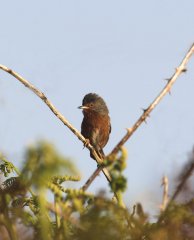 This small, dark, long-tailed warbler is a resident breeder in the UK but in low numbers. It has suffered in the past from severe winters: its population crashed to a few pairs in the 1960s, since when it has gradually recovered, increasing in both numbers and range.
Image copyright: Vic Froome (rspbimages.com)
This small, dark, long-tailed warbler is a resident breeder in the UK but in low numbers. It has suffered in the past from severe winters: its population crashed to a few pairs in the 1960s, since when it has gradually recovered, increasing in both numbers and range.
Image copyright: Vic Froome (rspbimages.com)
It is still regarded as an Amber List species of conservation concern. In the UK ‘Darties’ are at their northern limit, being more normally associated with Mediterranean climes – their range has expanded further north over recent decades though.

Males have a beautiful, soft, almost plum colour wash to their chest (females are more camouflaged). (Image copyright: Vic Froome (rspbimages.com))
On the Lizard there are a few pairs on the heaths (look for them around Kynance Downs); if you are lucky you may see a male perched on top of a gorse stem, tail cocked and feathers on his throat fluffed up as he sings to attract a mate and protect his territory.
Darties are easier to hear than see; often views are limited to a brief glimpse of a long-tailed ball of feathers flitting between gorse bushes and taller clumps of heather, so a good way of homing in on them is to get to know their call. A harsh nasal tchrr or their ‘tak’ contact call betrays their presence – be patient and hopefully you will be rewarded with a good view of this stunning little warbler. If you do spot them please do let us know.
 If you see a blur of feathers amongst the heather it might be a ‘Dartie’ (Image copyright: Ben Hall (rspbimages.com))
If you see a blur of feathers amongst the heather it might be a ‘Dartie’ (Image copyright: Ben Hall (rspbimages.com))
The UK population is thought to be about 3200 pairs but no national survey has been undertaken since 2006 and, with the succession of harsh and very wet winters since that time, numbers may well be lower. Their distribution is quite patchy and most often associated with heathland habitats. Darties typically build their nests in stands of gorse and can raise three broods of chicks in a good season. Invertebrates form the major part of their diet. Like many small passerines, Dartford warblers are not long-lived at three or four years maximum.
Published: January 2014 Author: Claire Mucklow RSPB Project Manager
{jcomments on}